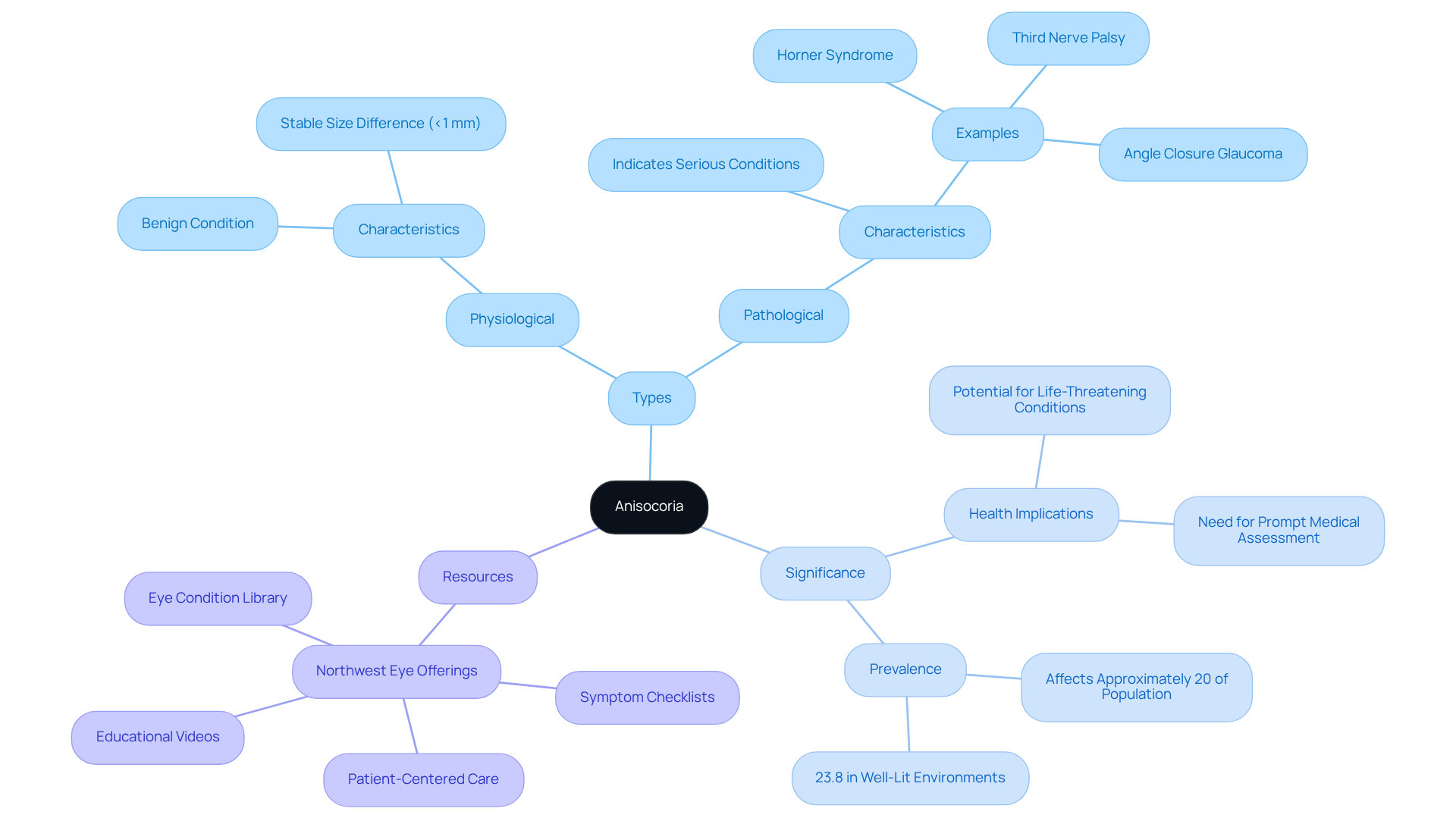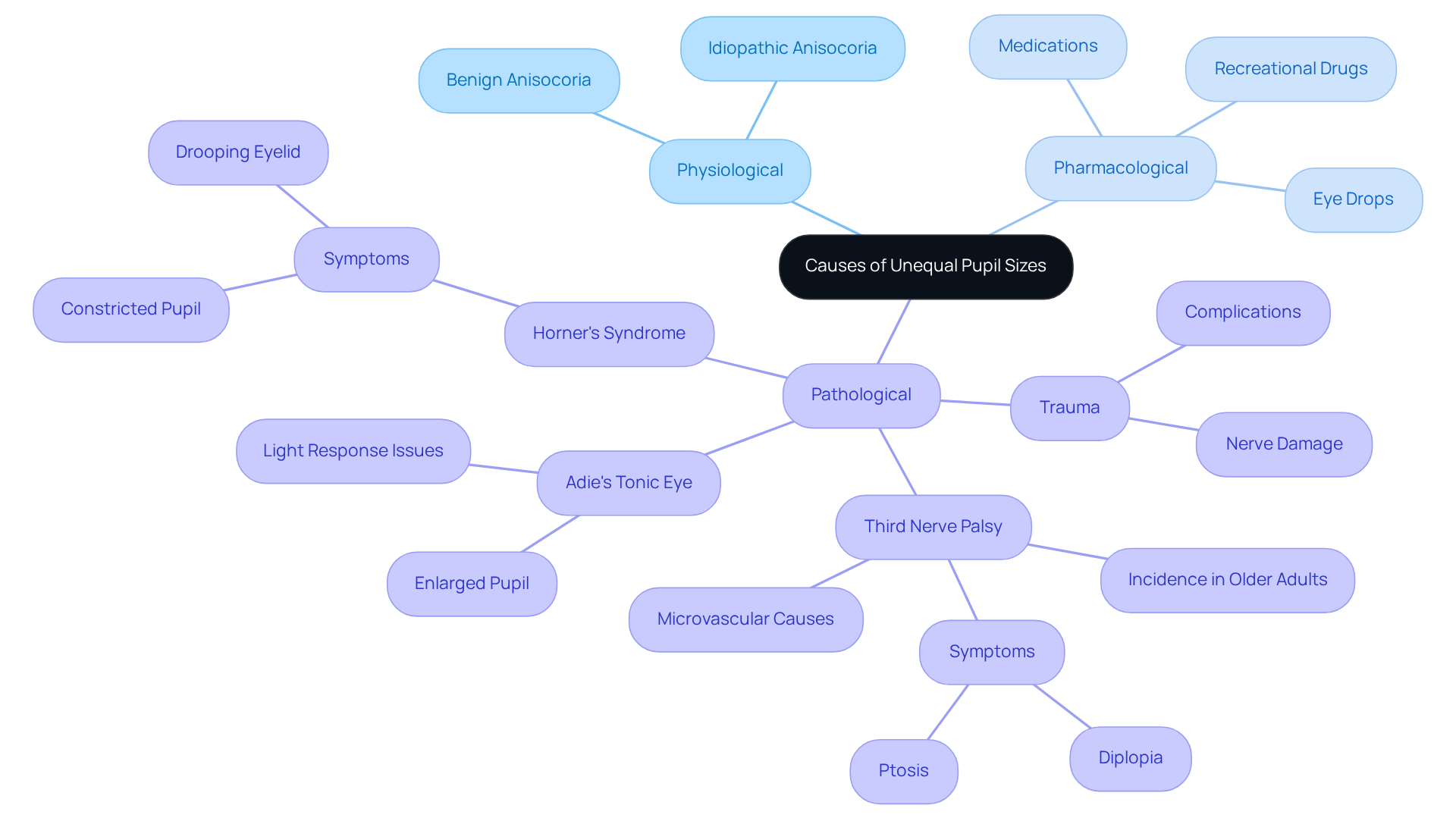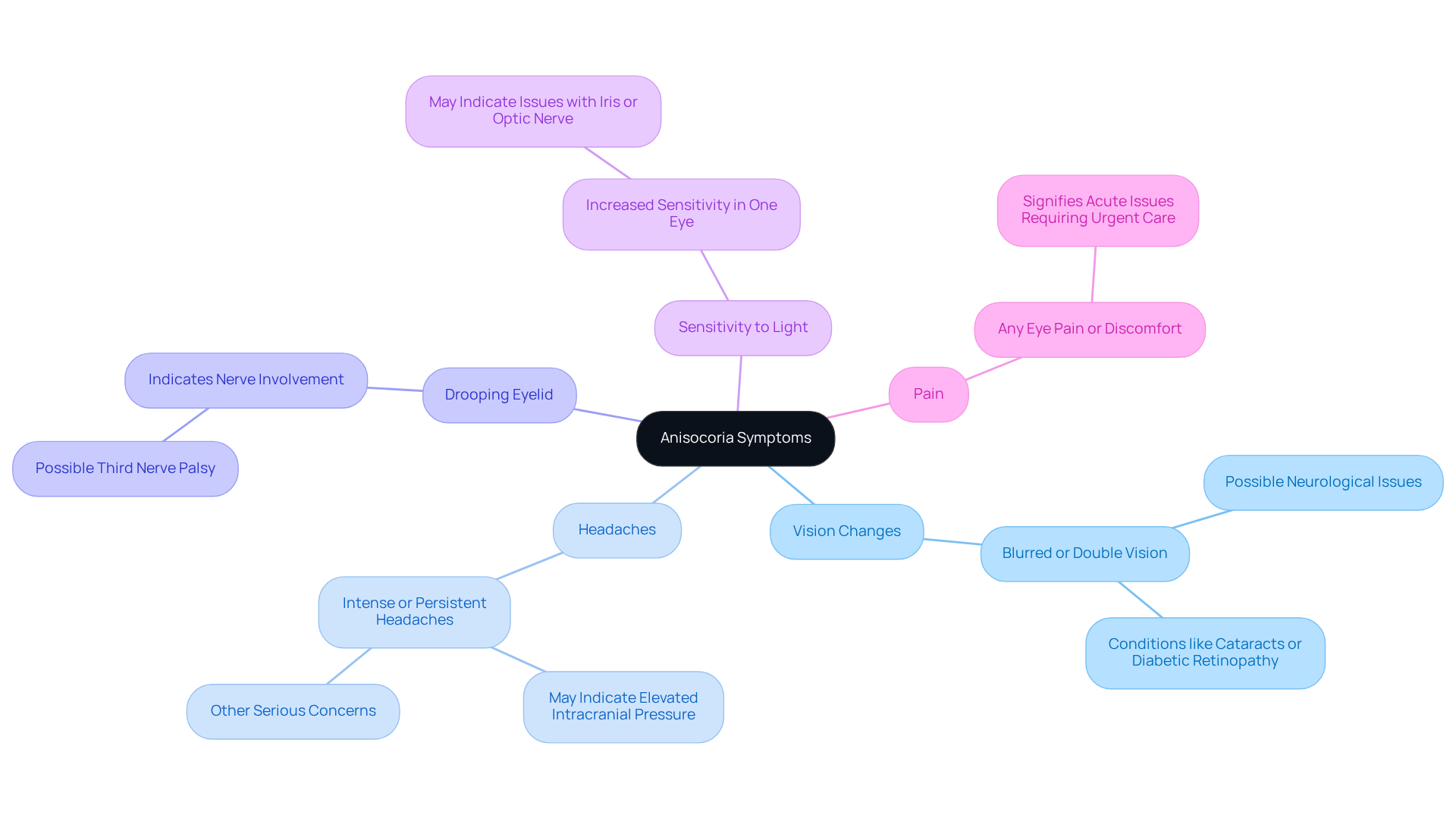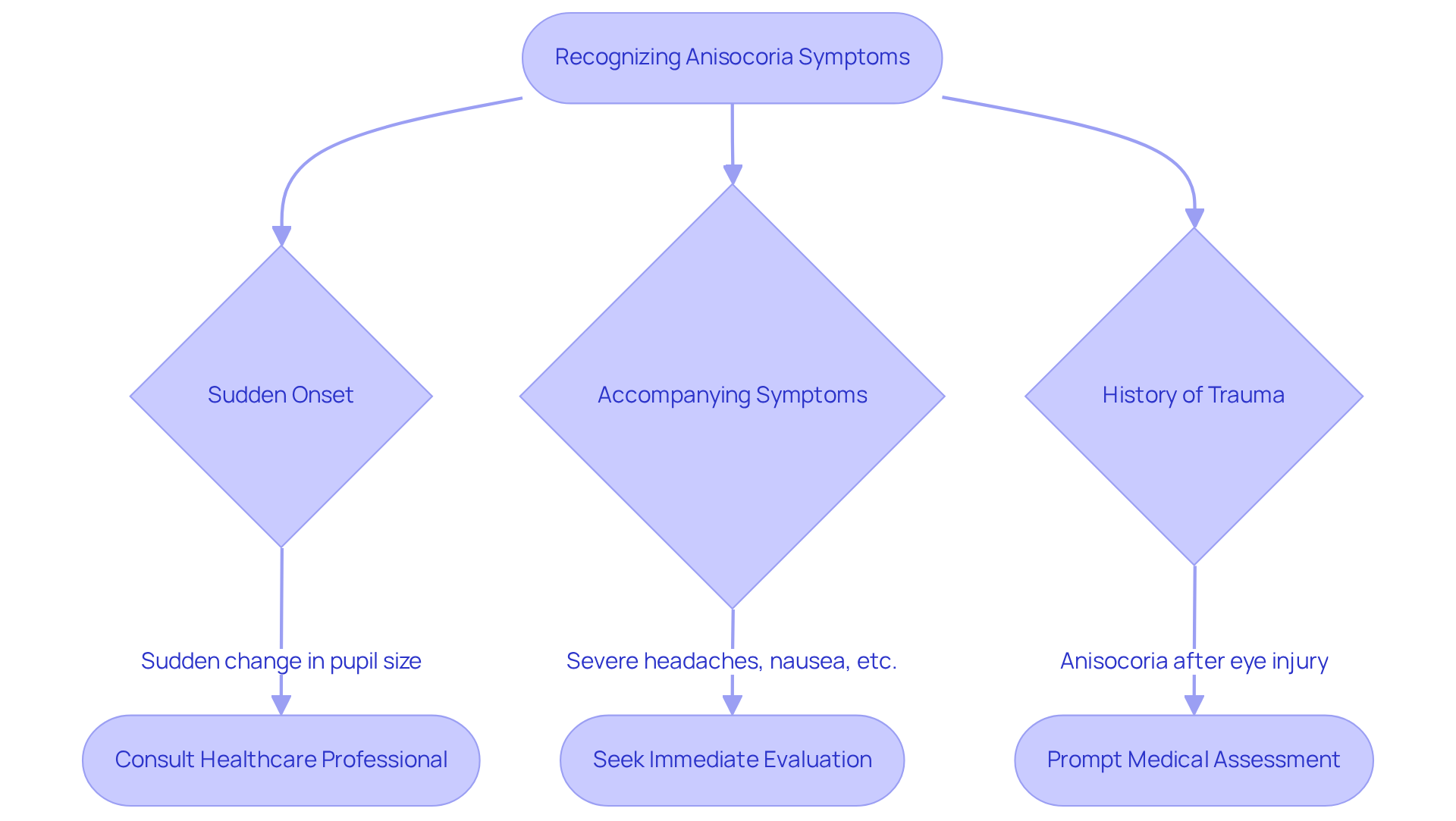Posted by: Northwest Eye in General on June 27, 2025
Overview
Anisocoria, where one pupil appears larger than the other, can arise from both benign physiological conditions and more serious pathological issues. Understanding this condition is crucial for your health assessment. We recognize that it can be concerning to notice such changes in your body.
While physiological anisocoria is common and typically harmless, it’s important to be aware that pathological causes, such as third nerve palsy or Horner’s syndrome, may require prompt medical evaluation. We understand that seeking care can feel daunting, but addressing these concerns early can prevent severe complications.
Recognizing associated symptoms is vital. If you notice any unusual changes, we encourage you to seek timely care. Remember, you are not alone in this journey, and we are here to help you through the process.
Introduction
Anisocoria, a condition where one pupil is larger than the other, affects nearly 20% of the population and can signal a range of health issues. We understand that noticing a difference in pupil size can be concerning, and it’s crucial to recognize the distinction between benign and pathological causes. The implications for eye health can vary significantly, and what may seem like a harmless difference could actually be a warning sign of a more serious condition.
This article delves into the causes, symptoms, and critical moments when medical attention is necessary. We are here to help you navigate the complexities of unequal pupil sizes, providing essential insights that can reassure you and guide you towards the care you may need.
Define Anisocoria and Its Significance
Anisocoria describes a condition characterized by one pupil bigger than the other, affecting approximately 20% of the population. We understand that noticing changes in your eyes can be concerning. This condition can be categorized into two main types: physiological and pathological. Physiological unequal pupil size is generally benign, involving a slight difference in size—typically less than 1 mm—and tends to remain stable over time. In contrast, pathological unequal pupil size may indicate serious underlying medical issues, such as nerve damage, Horner syndrome, or third nerve palsy, which can be life-threatening if not addressed promptly.
Identifying that one pupil is bigger than the other is important as it can suggest various health issues. While physiological conditions can cause one pupil bigger than the other and are usually harmless, pathological unequal pupil size requires prompt medical assessment to rule out critical conditions, including vision-threatening problems like angle closure glaucoma. Recent studies have shown that about 23.8% of individuals in well-lit environments exhibit unequal pupil sizes, highlighting its prevalence in clinical settings. A systematic evaluation process is essential for distinguishing between benign and serious causes of unequal pupil size, ensuring that you receive the appropriate care based on your specific needs.
At Northwest Eye, we offer designed to help you understand unequal pupil size and its effects on your eye health. Our resources include detailed articles, symptom checklists, and educational videos that clarify the causes and management of unequal pupil size. We are dedicated to patient-centered care, informing you about the symptoms, triggers, and contributing factors associated with your eye issue. If you have concerns about unequal pupil size or any other eye condition, we encourage you to schedule an appointment with a Northwest Eye doctor. We are here to help you through this process and provide tailored guidance to address your questions.

Explore Causes of Unequal Pupil Sizes
Differences in diameter, such as one pupil bigger than the other, can stem from various factors. These can be categorized into physiological, pharmacological, and pathological types. We understand that noticing these differences can be concerning. Physiological anisocoria is typically benign and may occur naturally without any underlying health issues, which can provide some reassurance. On the other hand, pharmacological factors may involve medications or substances, such as eye drops or recreational drugs, which can alter the size of the eye’s opening.
Pathological causes warrant more attention, as they can indicate serious conditions. Here are some key concerns:
- Third Nerve Palsy: This condition affects the oculomotor nerve, often resulting in a dilated pupil and potential drooping of the eyelid. Studies show that the incidence of third nerve palsy is notably higher in older adults, with an annual rate of 12.5 per 100,000 for those over 60 years compared to just 1.7 per 100,000 for younger individuals. The most common cause is presumed to be microvascular, accounting for 42% of cases.
- Horner’s Syndrome: Characterized by a constricted eye opening, drooping eyelid, and lack of sweating on one side of the face, this syndrome can signal serious underlying issues, such as a tumor or carotid artery dissection.
- Adie’s Tonic Eye: This state results in that responds inadequately to light but narrows gradually when concentrating on close objects.
- Trauma: Physical injuries to the eye or head can lead to unequal pupil sizes due to nerve damage or other complications.
Understanding these causes is essential for determining the appropriate course of action. It’s common to feel uncertain about when to seek medical evaluation. If you are experiencing symptoms like one pupil bigger than the other, eye discomfort, vision impairment, or rapid changes in size, we encourage you to seek medical advice promptly. Taking action can help exclude severe conditions and provide peace of mind.

Recognize Symptoms Associated with Anisocoria
Anisocoria, characterized by one pupil bigger than the other, can often be associated with other symptoms that may signal a more serious underlying issue. It’s important to be aware of key symptoms to monitor:
- Vision Changes: It’s common to experience blurred or double vision alongside anisocoria, which might indicate neurological issues that deserve further investigation. While blurred vision can stem from conditions like nearsightedness, farsightedness, or astigmatism, it may also point to eye diseases such as or diabetic retinopathy.
- Headaches: Intense or persistent headaches, especially when related to changes in eye size, could suggest elevated intracranial pressure or other serious concerns.
- Drooping Eyelid: If you notice a droop in one eyelid, it may indicate nerve involvement, particularly in cases of third nerve palsy, which requires prompt evaluation.
- Sensitivity to Light: Increased sensitivity in one eye might indicate underlying issues affecting the iris or optic nerve, necessitating medical attention.
- Pain: Any eye pain or discomfort should be addressed without delay, as it may signify an acute issue that requires urgent care.
Being aware of these symptoms is crucial, as they can guide you toward timely medical intervention. Research indicates that the phenomenon of one pupil bigger than the other is relatively common, with about 20% of the population experiencing some degree of pupil difference. However, when these differences manifest as one pupil bigger than the other and are accompanied by the aforementioned symptoms, they may suggest serious conditions such as aneurysms or strokes. This highlights the importance of seeking professional medical advice. We understand that navigating these symptoms can be concerning, and we are here to help you through this process.

When to Seek Medical Attention
Recognizing when to seek medical attention for anisocoria is crucial for ensuring optimal eye health. We understand that noticing changes in your eyes can be concerning, and we want to help you navigate this. Here are key scenarios that warrant immediate evaluation:
- Sudden Onset: If you notice a sudden change in pupil size, especially if accompanied by symptoms such as headaches or vision changes, this could indicate a serious underlying condition, including strokes or aneurysms, which can lead to permanent changes. It’s common to feel alarmed in such situations, but timely action is essential. A persistent disparity in pupil size, especially if one pupil is bigger than the other and it is a new occurrence, should prompt a consultation with a healthcare professional to assess potential causes. Approximately 20% of the normal population exhibits physiologic unequal pupil sizes, with one pupil bigger than the other, but any new or ongoing differences should be assessed. Remember, seeking help is a sign of strength.
- Accompanying Symptoms: The presence of additional concerning symptoms—such as severe headaches, nausea, vomiting, or neurological deficits—requires immediate medical evaluation, as these may signal serious health issues, including brain aneurysms, strokes, and infections like meningitis. We understand how frightening this can be, and we encourage you to reach out for support.
- History of Trauma: Anisocoria that develops following an eye injury or head trauma necessitates prompt medical assessment to rule out complications like cranial nerve damage or other serious conditions. Your safety and health are our top priorities.
Timely intervention is vital, as it can significantly influence outcomes. are essential for early detection of potential causes of anisocoria. Being vigilant about changes in pupil size and associated symptoms is essential for maintaining eye health. We are here to help you through this process and ensure you receive the care you need.

Conclusion
Anisocoria, or the condition of having one pupil larger than the other, is a phenomenon that affects many people. We understand that noticing this change can be concerning. While it often is benign and physiological, it’s crucial to remain vigilant, as significant disparities in pupil size may indicate serious underlying health issues. Understanding the distinction between physiological and pathological anisocoria is essential for ensuring timely and appropriate medical care.
In this guide, we have explored the various causes of unequal pupil sizes, including physiological variations, pharmacological influences, and serious conditions such as third nerve palsy and Horner’s syndrome. It’s common to feel overwhelmed by these possibilities, but recognizing associated symptoms—such as vision changes, headaches, and light sensitivity—can aid in identifying when medical attention is necessary. Remember, seeking prompt evaluation in cases of sudden changes or concerning symptoms is vital, as early detection can lead to better outcomes.
Ultimately, awareness and education about anisocoria and its implications are vital for maintaining eye health. We encourage you to monitor your eye health closely and consult healthcare professionals when abnormalities arise. By fostering a proactive approach to eye care, you can ensure not only peace of mind but also the best possible health outcomes. We are here to help you through this process.
Frequently Asked Questions
What is anisocoria?
Anisocoria is a condition characterized by one pupil being larger than the other, affecting approximately 20% of the population.
What are the two main types of anisocoria?
The two main types of anisocoria are physiological and pathological. Physiological anisocoria is generally benign and involves a slight difference in pupil size, while pathological anisocoria may indicate serious underlying medical issues.
What distinguishes physiological anisocoria from pathological anisocoria?
Physiological anisocoria typically involves a difference in pupil size of less than 1 mm and remains stable over time, while pathological anisocoria may suggest conditions such as nerve damage, Horner syndrome, or third nerve palsy, which can be life-threatening if not addressed.
Why is it important to identify anisocoria?
Identifying anisocoria is important because it can indicate various health issues. While physiological anisocoria is usually harmless, pathological anisocoria requires prompt medical assessment to rule out serious conditions, including vision-threatening problems like angle closure glaucoma.
How common is anisocoria in well-lit environments?
Recent studies have shown that about 23.8% of individuals in well-lit environments exhibit unequal pupil sizes, highlighting its prevalence in clinical settings.
What resources does Northwest Eye provide for understanding anisocoria?
Northwest Eye offers a comprehensive Eye Condition Library that includes detailed articles, symptom checklists, and educational videos to help understand unequal pupil size and its effects on eye health.
What should I do if I have concerns about anisocoria?
If you have concerns about unequal pupil size or any other eye condition, it is recommended to schedule an appointment with a Northwest Eye doctor for tailored guidance and care.






